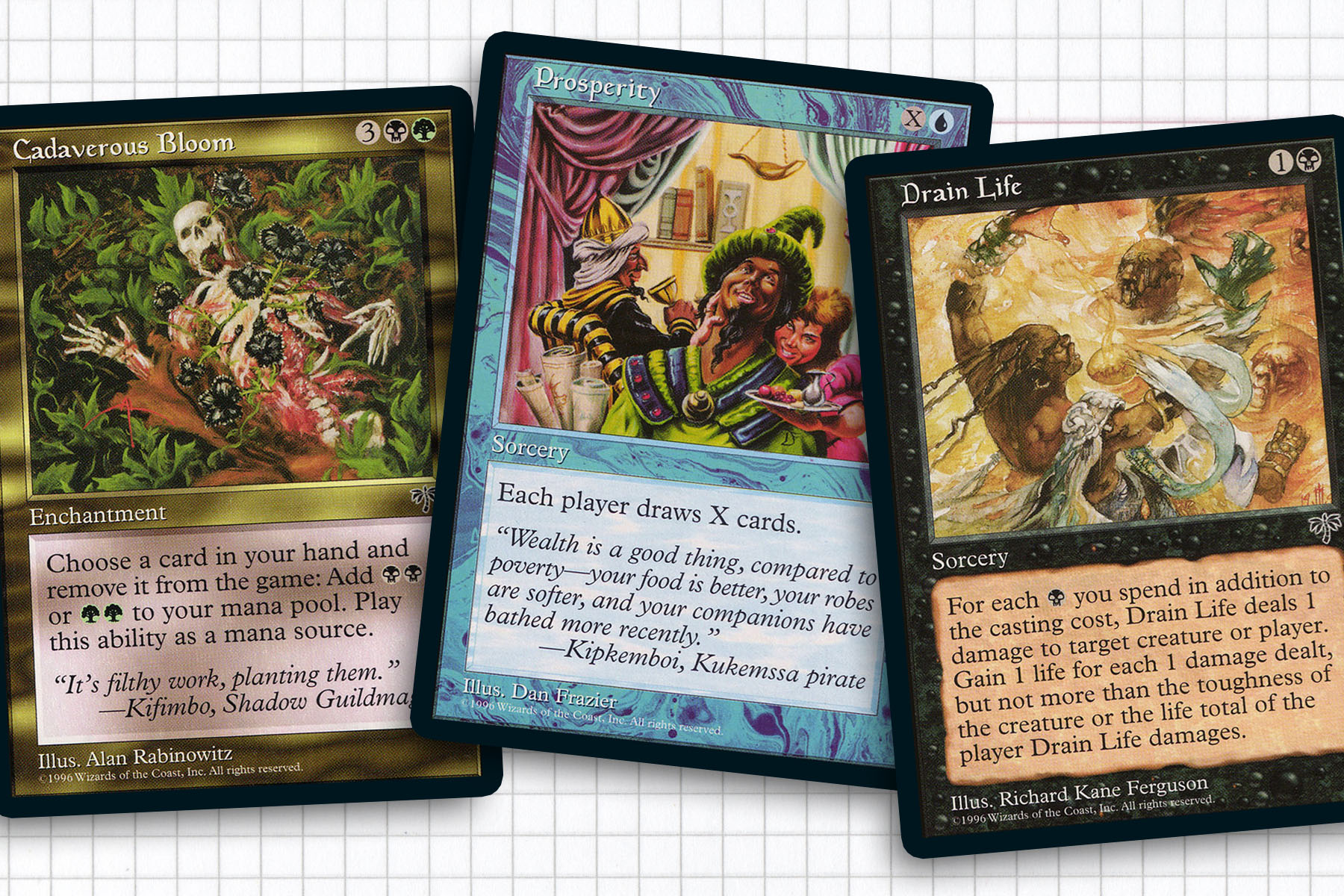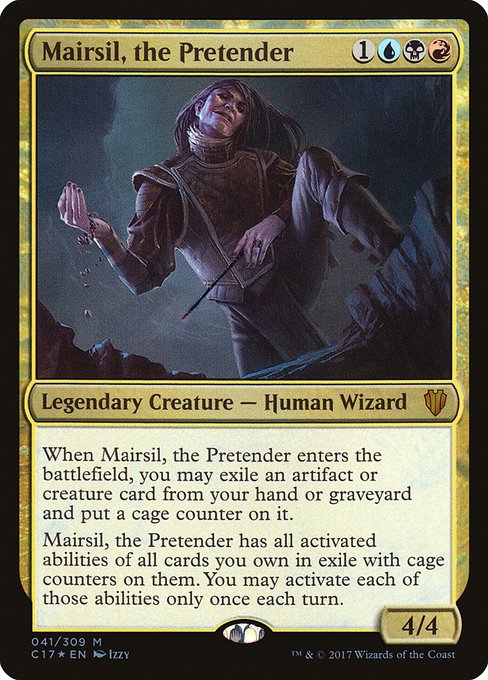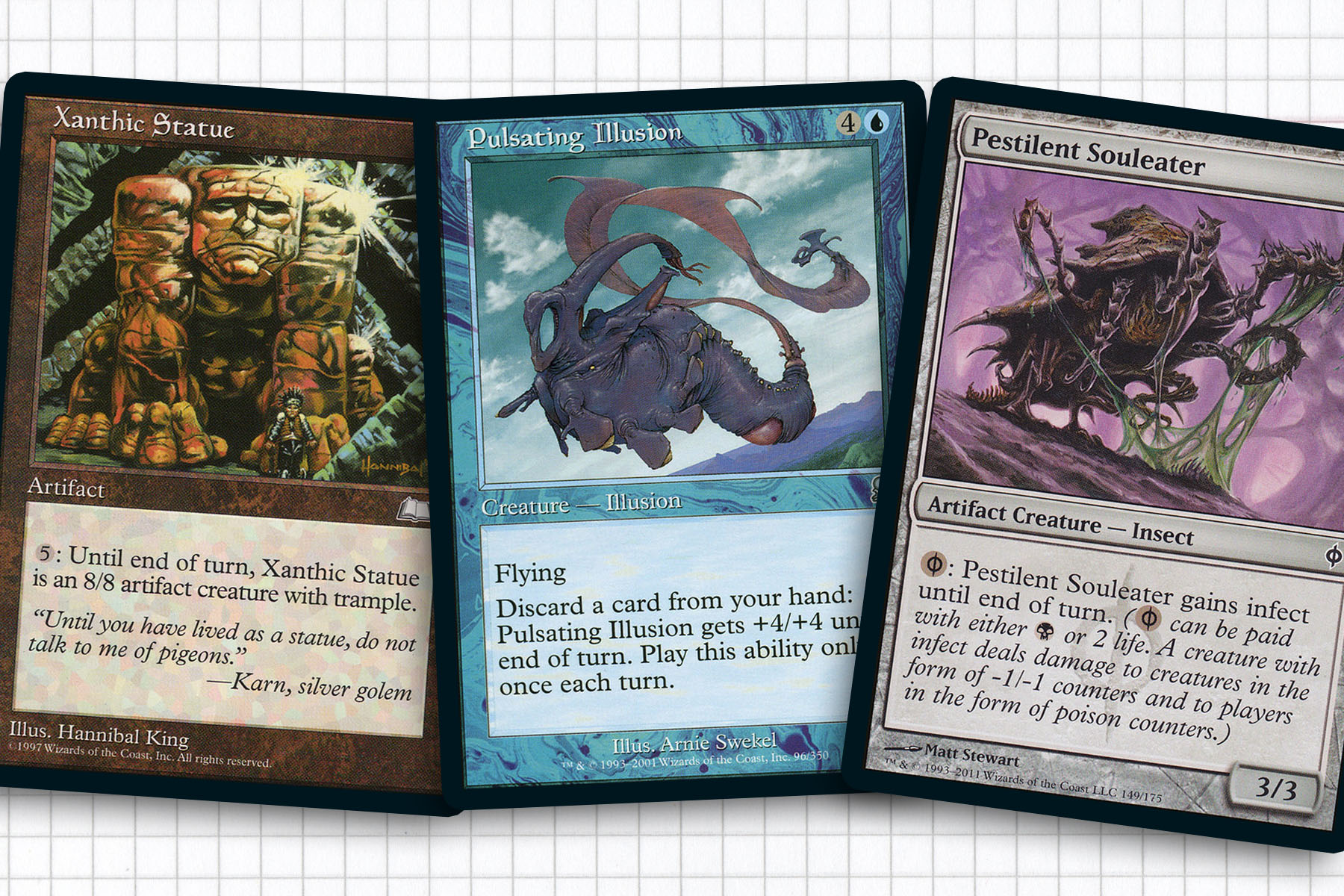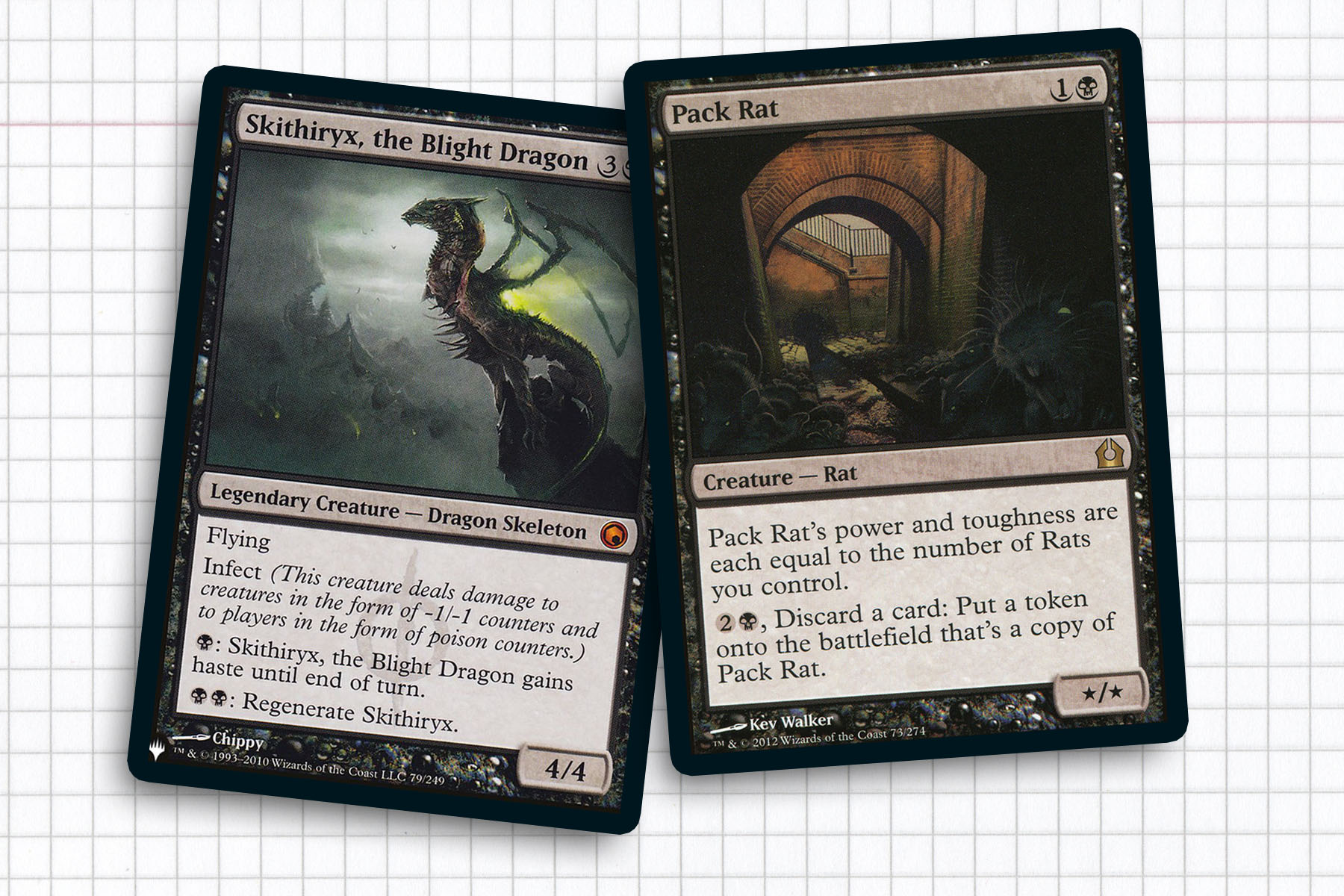From my personal experience, I’ve noticed that the life cycle of a Magic player generally starts with playing aggressive decks. They are usually the easiest to wrap your mind around and require the least amount of explanation as to how to properly run. “You want to play creatures that are all elves, so your lords all enhance them,” or “just cast spells that cost less than three and deal damage.”
Depending on your personality, the next stage can go either in the direction of playing control or combo. My own personality drove me into a direction where I would play Serra Angels and Fog-variants and try to survive long enough to win games. But it’s hard to overlook just how interesting combo decks can be, even if I’ve never been especially proficient with them.
Combo decks utterly fascinate me. While obviously a very broad umbrella, they can often be the result of either an accident or a lot of critical thinking to find the perfect mix of cards to fight or defy a metagame. Combo decks highlight the importance of the synergies built into card interactions, as well as reward proper deck construction. Many competitive combo decks have proven easy to learn, but difficult to master.
Left to my own devices, my original combos are pretty laughable. My first combo deck used Kiki-Jiki, Mirror Breaker, Seeker of Skybreak, and Heedless One to take out three players at once—and that was the result of an early morning deck building session before school in 2006. Years later, during Innistrad Standard, I comboed Master’s Call with Shape Anew in a deck whose only artifact cards were three copies of Blightsteel Colossus. Pretty sure I went 2-2 during FNM.
This week, I would like to take a look at one of my favorite decks, which in many ways is just a pile of interlocking pieces that might be considered combos.

A History with Combos
Combo decks have existed since the very beginning of Magic, when the most notorious combo was Channel and Fireball. But in terms of competitive-viable combos, the first notable one within Standard was the Prosperous Bloom deck; which used Cadaverous Bloom to cast a large Prosperity, leading to more Prosperities, before finally exiling cards to a Drain Life.
Over the last twenty years, we’ve seen combo decks come into their own through all kinds of varieties and kicks into another gear once we step into larger formats, like Legacy and Commander. From Goblin Charbelcher and Mana Severance or Deceiver Exarch and Splinter Twin in competitive formats, to Demonic Consultation and Thassa’s Oracle in Commander, people never tire of comboing off.
I have been playing long enough and paying close enough attention to the nuances of Magic’s rules that I could conceivably play a combo deck that means to win on the stack, such as a Storm deck. But in order to purposely dodge that feeling of my opponent questioning the more complex edges of the rules, I like to have my combos be something that wins either in a very straightforward way—like Nekusar, the Mindrazer, Phyresis, and Windfall—or purely in the combat step—like Aggravated Assault and Savage Ventmaw. As a result, my average combo plays can be telegraphed and not too important to the deck overall. Despite that mindset, if I ever develop a Prosperous Bloom deck in Commander that I am happy with, it will be one of the first things I write about.
While I may shy away from combos, they absolutely have their place. The depth of Commander allows for an expansive pool of potential combos. Most combos in Commander are engines like Reassembling Skeleton, Ashnod’s Altar, Pitiless Plunderer, and Mayhem Devil, allowing them to run ad nauseam and taking advantage of the free form nature of playing in a physical space. You just declare that uncontested, you’ll run the engine enough times to deal lethal damage to all of your opponents and the game comes to an end. Then, of course, there are combos like Approach of the Second Sun and Doom Whisperer or Cryptic Annelid, which don’t win on the spot, but challenge the table to answer it immediately.
The closest thing to a combo deck that I have in my regular rotation is my Mairsil, the Pretender, which looks to play its own relatively isolated game until it’s set up the pieces to take out players on its own terms. The deck has been a mainstay of my collection since Mairsil premiered in Commander 2017, and a lot of the fun has come from the offbeat style that the general demands. What results is a deck that keeps me engaged in the game and on my toes.

Commander: Mairsil, the Pretender
Creatures: Aetherling, Amaranthine Wall, Arcanis the Omnipotent, Argent Sphinx, Asmodeus the Archfiend, Blighted Bat, Cavern Harpy, Cephalid Inkshrouder, Deadeye Navigator, Endling, Flowstone Sculpture, Gingerbrute, Glen Elendra Archmage, Hateflayer, Horseshoe Crab, Kozilek, the Great Distortion, Mercurial Chemister, Mindless Automaton, Myr Propagator, Oriq Loremage, Pack Rat, Pestilent Souleater, Pulsating Illusion, Putrid Imp, Sakashima the Impostor, Shauku, Endbringer, Shriekdiver, Skithiryx, the Blight Dragon, Skywing Aven, Torchling, Trespassing Souleater, Viashino Heretic, Yahenni, Undying Partisan
Artifacts: Ashnod’s Altar, Bag of Holding, Basalt Monolith, Cauldron of Souls, Conjurer’s Closet, Heartstone, Mnemonic Sphere, Nevinyrral’s Disk, Phyrexian Totem, Rings of Brighthearth, Surveyor’s Scope, Throne of Empires, Trading Post, Urza’s Bauble, Wayfarer’s Bauble, Xanthic Statue
Enchantments: Freed from the Real, Pemmin’s Aura
Instants: Ancient Excavation, Arcane Denial, Entomb, Essence Flux, Frantic Search, Planar Incision, Read the Runes
Sorceries: Cathartic Reunion, Faithless Looting, Final Parting, Ransack the Lab
Lands: 7 Island, 5 Mountains, 6 Swamp, Blightstep Pathway, Bojuka Bog, Choked Estuary, Clearwater Pathway, Command Tower, Crumbling Necropolis, Dragonskull Summit, Drossforge Bridge, Drowned Catacomb, Frostboil Snarl, Karn’s Bastion, Mistvault Bridge, Polluted Mire, Port of Karfell, Remote Isle, Riverglide Pathway, Silverbluff Bridge, Smoldering Crater, Sulfur Falls

Interlocking Pieces
The unique design of Mairsil allows for activated ability interactions to occur that were not the original intention of the game designers. For example, Asmodeus the Archfiend and Shauku, Endbringer were both designed in such a way that their activated abilities come at the cost of their downsides. But Mairsil does not pick up these downsides, meaning that with enough resetting of Mairsil, our general can have a stack of abilities that may not result in an immediate victory, but certainly make winning far more entertaining. The deck plays pieces of combos that come together in weird ways and often defy certain expectations of unprepared opponents,
As someone who likes to win through combat, the combination of Pestilent Souleater and Trespassing Souleater are the key pieces to fast infect victories when used alongside cards like Hateflayer, Xanthic Statue, and Pulsating Illusion. The nice part about Mairsil’s form of combo playing is that the pieces are hard to interact with, because most people don’t bother to play Riftsweeper or Processors. This also means that something like an infect win does need to be completed in a single turn. But we have enough options that by the twilight turns of the game, we just might be able to string together some +1/+1 counter interactions to make an infect victory a single turn experience.
At its core, the deck is a web of disparate interactions. One of my favorites as of late has been Endling/Cauldron of Souls and Glen Elendra Archmage, allowing me to counter noncreature spells and get an additional enter the battlefield trigger. Additionally, the recent inclusion of Nevinyrral’s Disk has meant that I have a way to consistently wipe the board on most turns, only improved if Mairsil has the ability to blink themselves.
An innovation that I spoke about the last time I touched on Mairsil was the importance of pieces of the deck being manaless activated abilities. Because Mairsil can grab creatures or artifacts from our hand or graveyard, discarding a card to the activated abilities of Cephalid Inkshrouder, Kozilek, the Great Distortion, Putrid Imp, or Skywing Aven doesn’t penalize us at all. Additionally, tapping Marsil to draw three cards with Arcanis the Omnipotent’s ability means that at the cost of a single mana, we can untap with Torchling, gaining card advantage and retaining a blocker.

Reset and Go!
Blink decks are a mainstay of Commander, but in most cases the aim is to be blinking different creatures in and out of play on any given turn. For this deck we want to either be cloning or blinking Mairsil as often as possible, to the point where it can become a crucial opening hand decision. Aetherling, Argent Sphinx, Conjurer’s Closet, Myr Propagator, and Pack Rat all fill this niche, with the Pack Rat probably being the most effective of the pieces.
The goal is to chew up our graveyard or hand to the point of being able to either protect our commander by granting it some proximity of shroud or returning it to our hand instead of the commander zone. This is a line of play that I noticed a lot of people who are unfamiliar with the deck don’t immediately grasp until Mairsil has acquired a handful of abilities pretty effortlessly.
It is extremely common for Mairsil to be entering the battlefield over and over on a regular basis. Because of this, it becomes important to find ways to give our general haste through Blighted Bat, Shriekdiver, and Skithiryx, the Blight Dragon. These three are important enough to drive opening hand decisions as well and will typically be one of the cards I am searching for with Final Parting, Oriq Loremage, or Entomb, just after Pack Rat or Aetherling.
I said this deck was the closest thing in my regular rotation to a combo deck and that really comes from how much forethought I need to put into all the decisions I make. A poor opening hand or line of play can be the difference between a game that I drive the forward motion of and one where I’m barely a presence. Even if there are no exact combos that I am looking to execute on at a moment’s notice to steal wins, the deck requires that I know the list pretty well, so that I can always have a Plan B ready in waiting.
I live for the moments when a player sees the interactions between two random cards come together on Mairsil and realize that they have no proper way to interact, beyond creature removal. This feeds into my intended subject for next time, looking at threat assessment through the lens of a recent Neon Dynasty general. That one has been coming together behind the scenes for a few weeks now and I really hope you all will enjoy it.
Ryan Sainio is a Graphic Designer who writes about EDH and the EDH community. He has been playing Magic: the Gathering since 7th Edition in 2002 and values flavorful and fun gameplay over competitively optimized decks.

